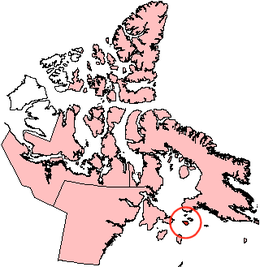Nottingham Island

 Nottingham Island, Nunavut | |
| Geography | |
|---|---|
| Location | Hudson Strait |
| Coordinates | 63°17′N 77°55′W / 63.283°N 77.917°W |
| Area | 1,372 km2 (530 sq mi) |
| Administration | |
Canada | |
| Territory | Nunavut |
| Region | Qikiqtaaluk |
| Demographics | |
| Population | Uninhabited |
Nottingham Island (Inuktitut: Tujjaat) is an uninhabited island in the Qikiqtaaluk Region of Nunavut, Canada. It is located in Hudson Strait, just north of the entrance into Hudson Bay.[1]
History
[edit]Nottingham Island was named by the English explorer Henry Hudson in 1610. A weather station was constructed on the island in 1884. In 1927, an airfield was constructed as part of a program to monitor ice in Hudson Bay. The island became uninhabited in October 1970 as Inuit residents migrated to larger towns, primarily Cape Dorset.
Fauna
[edit]The island is known for its prominent walrus population.
Notable residents
[edit]It is the birthplace of the late Inuit artist Pitseolak Ashoona as well as photographer Peter Pitseolak.
References
[edit]- ^ Trémaudan, Auguste Henri de Trémaudan (1916). The Hudson Bay road (1498-1915) (Digitized Jul 10, 2008 ed.). J.M. Dent. pp. 50.
Nottingham Island hudson.
External links
[edit]

